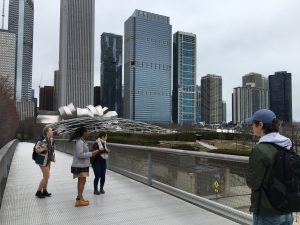 In the past two weeks, my classmates and I have wandered through various parts of Chicago. From Uptown to the UChicago campus, we’ve passed walls of murals, popped our heads into random music venues, people-watched at Lincoln and Millennium park, and eaten nearly everything in sight. Nevertheless, visiting the Chicago History Museum illuminated many aspects of this city and helped me to see the various neighborhoods through a historical lens.
In the past two weeks, my classmates and I have wandered through various parts of Chicago. From Uptown to the UChicago campus, we’ve passed walls of murals, popped our heads into random music venues, people-watched at Lincoln and Millennium park, and eaten nearly everything in sight. Nevertheless, visiting the Chicago History Museum illuminated many aspects of this city and helped me to see the various neighborhoods through a historical lens.
We visited the museum in lieu of class on Friday and were encouraged to take our time at each exhibit. I savored every moment, as I hope to do my final project on the history of Chicago. This coming week we are working on these independent research projects at the Newberry Library. While we are permitted to explore any topic that the library’s collection specializes in, I want to learn more about Chicago. I am particularly interested in the planning of the city. In what ways did city planners push a segregationist agenda? What measures have been taken to create more integration of race in class in this city? Do the lines that were drawn between neighborhoods limit certain groups’ access to public spaces? These are all questions that I want to explore by utilizing the Newberry’s collection.
The Chicago History Museum placed a focus on this topic through its various exhibits. One plaque read, “the contours of the city have been shaped by successive waves of people from various parts of the U.S. and other nations.” While this can be said of practically all of America’s cities, I found it particularly interesting because it connects to something we discussed in class during our first week here. That is, we learned that it’s important to understand that a city is a palimpsest. Like a piece of writing, cities often have a layered history wherein certain aspects of it may be erased but traces of its history remain. Each neighborhood has a legacy of its past. For example, a few students took the wrong bus one day and ended up in a neighborhood called “Back of the Yards.” We later learned that this name is an allusion to the area’s history of stockyards. Chicago is known for its meatpacking past. I learned in the museum that a combination of labor struggles and negative environmental impacts contributed to its demise.
Also in the museum was an exhibit about Chicago’s jazz scene. While jazz has its roots in New Orleans, it spread north to Chicago during The Great Migration and legends such as Louis Armstrong took the windy city by storm in the 1920s.
I scribbled various notes throughout my exploration of the museum. Each serve as a sort of “seed” for my research. I want to know more about A. Phillip Randolph and the Chicago Housing Authority. I hope to explore the intricacies of the 1996 “Plan for Transformation.” Most of all, I’m excited to delve deeper into this city’s influential figures. From Superintendent Ben Willis—who is notorious for school segregation in Chicago—to the admirable nurses and doctors at Provident Hospital, the first African-American owned and operated hospital in America. Overall, I learned a little about a lot of different topics at the museum which will serve as a broad base of exploration in the coming weeks.